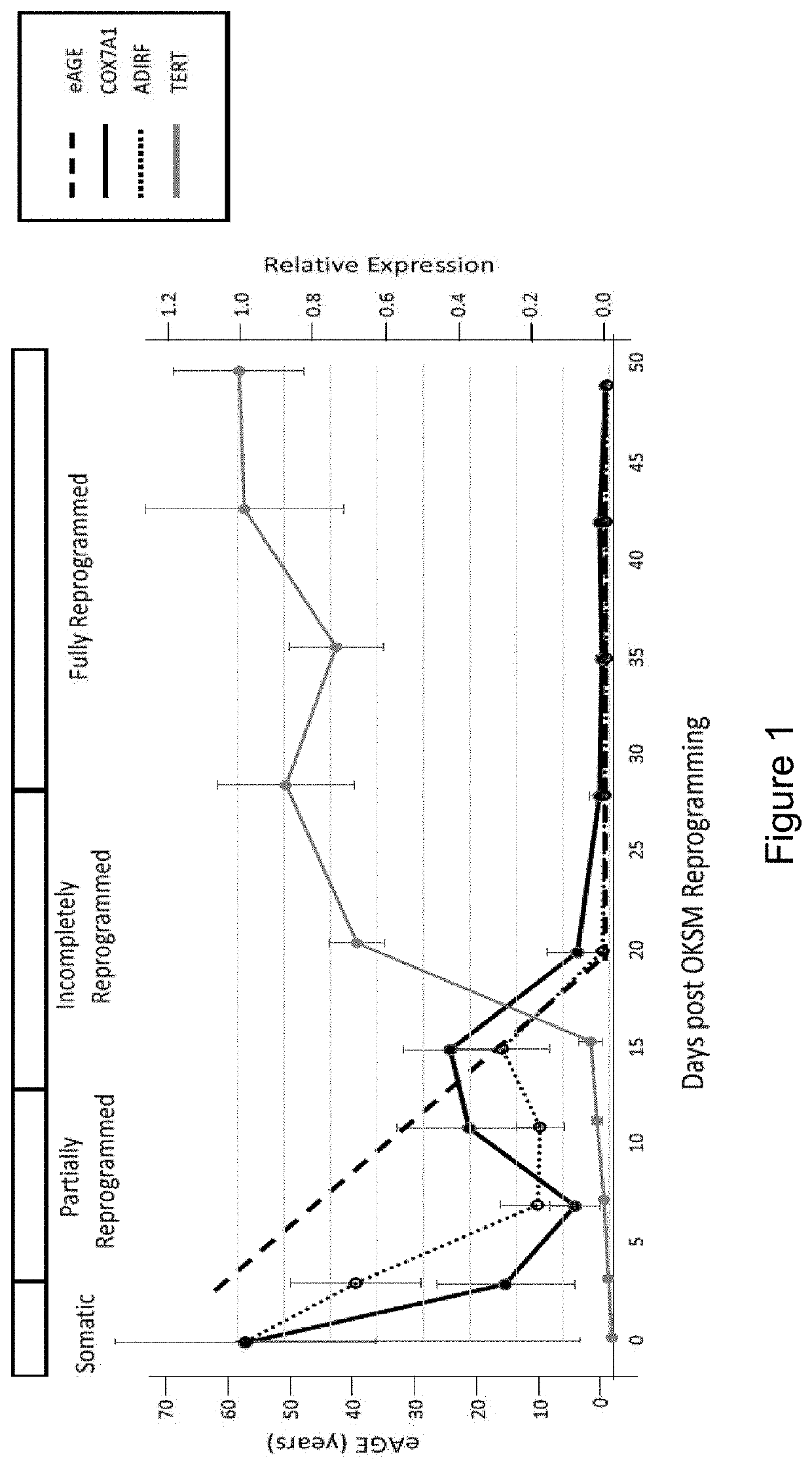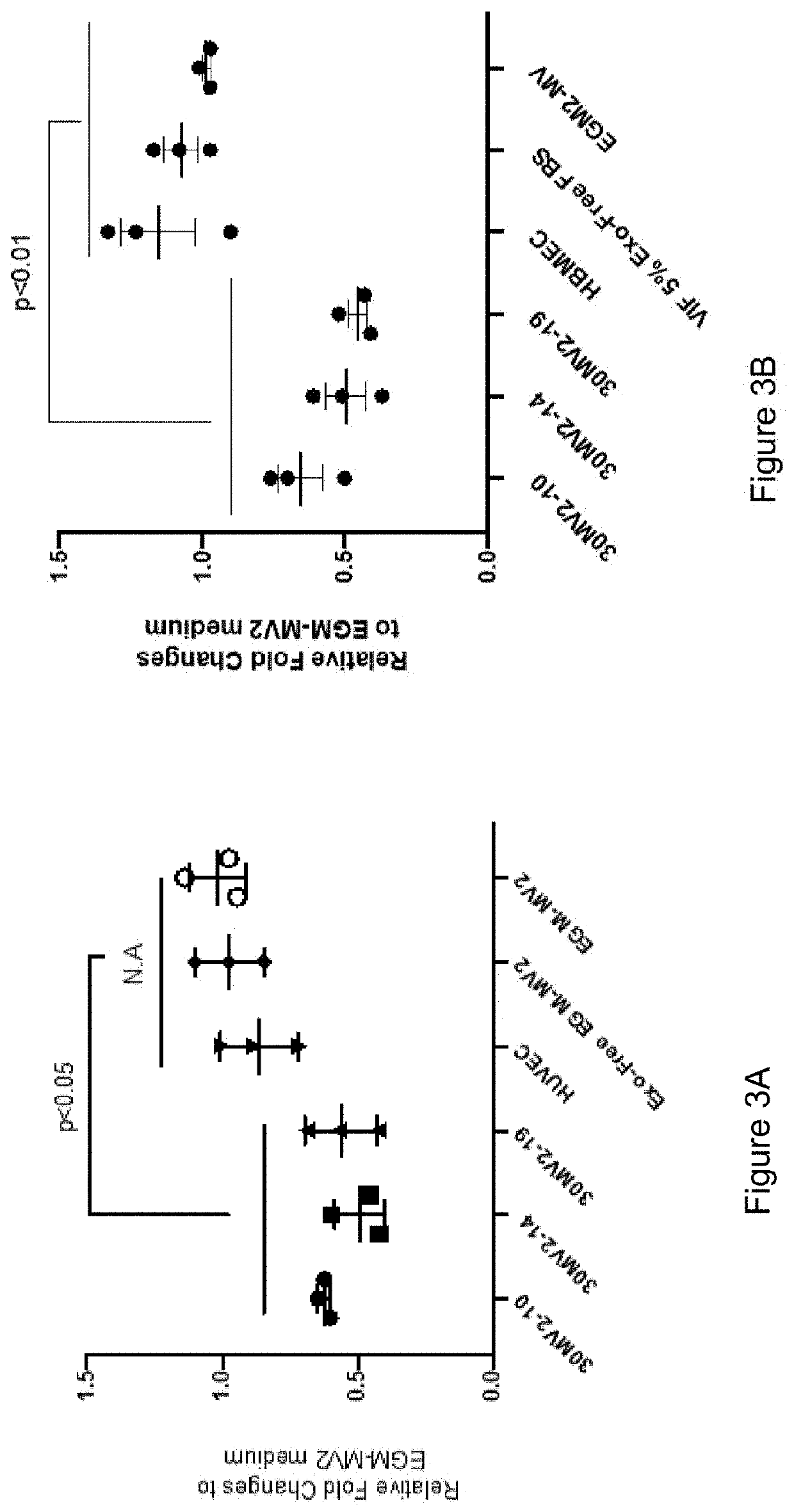Induced tissue regeneration using extracellular vesicles
a tissue regeneration and extracellular technology, applied in the field of in vivo delivery of factors, can solve the problems of limited reproducibility, risk of unwanted gene modification, and potential for unwanted cell growth such as tumor formation, and achieve the effects of restoring regenerative capacity, preventing, slowing or reverseing the loss of regenerative capacity, and improving various hallmarks of aging such as epigenetic profile, telomere length and/or mitochondrial fitness
- Summary
- Abstract
- Description
- Claims
- Application Information
AI Technical Summary
Benefits of technology
Problems solved by technology
Method used
Image
Examples
example 1
ed Medium from Embryonic Progenitor Endothelial Cells Down Regulates COX7A1 in Fetal / Adult Human Vascular Endothelial Cells
[0177]Secreted factors in the conditioned medium from clonal embryonic endothelial progenitor cell eEPC lines were tested to determine if they could confer an embryonic gene expression pattern onto fetal / adult endothelial cells. Medium (EGM-MV2 basal medium supplemented with VEGF, IGF2, and FGF2 (VIF)) from 3 clonal eEPC cell lines (30-MV2-10, 30-MV2-17, and 30-MV2-19) was collected after a 72-hour incubation with cells at 37° C., 5% 02, 10% CO2. HUVEC (human umbilical cord vein cells) or HBMVEC (human brain microvascular endothelial cells) at ˜80% confluency were washed 2× with PBS and their growth medium was replaced with conditioned medium from 30-MV2-10, 30-MV2-17, or 30-MV2-19. Cells were incubated for 72 hours in conditioned medium before harvesting for RNA extraction. RNA was isolated and gene expression assessed by quantitative rtPCR using standard metho...
example 2
from Embryonic Progenitor Cells Down Regulate COX7A1 in Adult Endothelial Cells
[0179]Exosome enriched fractions from the conditioned medium of embryonic endothelial progenitor cell lines (30-MV2-10, 30-MV2-14 and 30-MV2-19) were prepared by ultrafiltration of the conditioned medium that was prepared as described in Example 1. The medium was centrifuged at 300×g for 5 min. at room temperature followed by 1000 xg for 10 min. followed by filtration through a 0.22 uM filter. The filtered medium was centrifuged at 10,000×g for 10 minutes at 4° C. The medium was then concentrated 300× by centrifugation through an Amicon Ultra-70 100 kDa cutoff device at 1000 xg for 1 hour. The HUVEC were plated at ˜80% confluency and incubated in EGM-MV2 medium containing exosome free FCS.
[0180]The exosome enriched preparations from embryonic or HUVEC cell conditioned media were added to a final concentration of 10× (1:30 dilution) at day 0 and at day 3. The conditioning medium (exosome free medium) witho...
example 3
netically-Modified Human Embryonal Carcinoma Cells as a Source of Exosomes for Use in ITR
[0181]EC cells are a preferred embodiment as a source of pluripotent cell-derived EVs because of the ease of genetic modification, clonal expansion, scale up of the cells. In the case of producing iTR EVs from EC cells, the EC cell line designated ReCytel is modified by the exogenous introduction of combinations of TERT, LIN28B SOX2, MYC, NANOG, and OCT4 such that the levels of the corresponding mRNAs are expressed at least 2-fold, or more preferably at least 10-fold, and most preferably, at least 50-fold higher than the native cell. Reduced immunogenicity of the EVs is also be accomplished by knockout of the Class I HLA antigen function through the knockout of beta2-microglobulin and the overexpression of HLA-G. Exosomes are isolated from the cell supernatant of the resulting cells cultured in standard cell culture vessels or bioreactors, by differential centrifugation followed by ultracentrifu...
PUM
 Login to View More
Login to View More Abstract
Description
Claims
Application Information
 Login to View More
Login to View More - R&D
- Intellectual Property
- Life Sciences
- Materials
- Tech Scout
- Unparalleled Data Quality
- Higher Quality Content
- 60% Fewer Hallucinations
Browse by: Latest US Patents, China's latest patents, Technical Efficacy Thesaurus, Application Domain, Technology Topic, Popular Technical Reports.
© 2025 PatSnap. All rights reserved.Legal|Privacy policy|Modern Slavery Act Transparency Statement|Sitemap|About US| Contact US: help@patsnap.com



